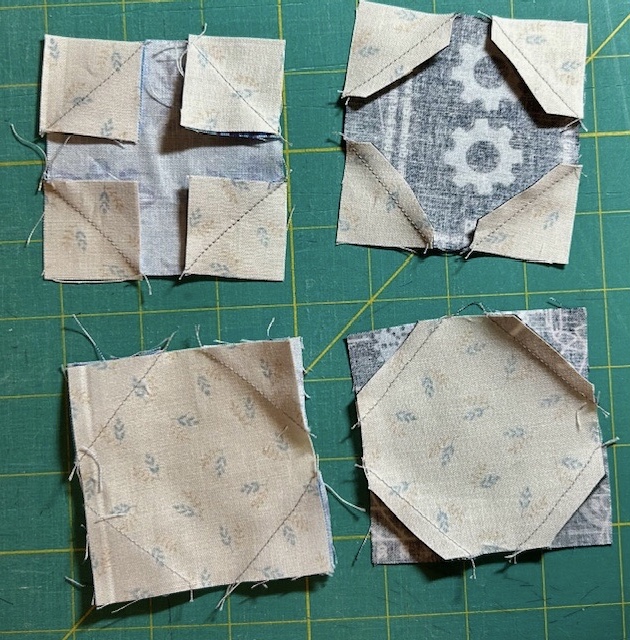We all get to be young but only the lucky get to be old.
Quilting
My eldest grandson requested a new twin quilt in blue and cream with more lights than darks. Ok; counterpane blocks. But the blocks can’t be too large because the quilting will be something simple like curves or parallel lines.
I’ve been mindlessly making four-patches of scraps… so while a four- or nine-patch sounds good, it needs to be changed up. What about a nine-patch of snowballs? They could be fairly small. Six-inch blocks sound good but two-inch snowballs do not. Two-and-a-half inch snowballs make a 7.5” block which will work.
Years ago I made a nine-patch snowball and used snowballs in the border. In the first example, the snowball square is divided into thirds to locate the triangles. The snowball border used scraps for the corners so none are exactly the same. In fact, there was no planned corner size. This time I want the snowball to have a smaller, but uniform, corner. What if the corners each take one fourth of a side length? The corners would finish at five-eighths inch. Small but possible.
The snowballs are cut 3" and the corner squares are 1.25". Because they are so small I didn't mark the diagonals but just sewed across. There are five dark centers and four light centers in each octagon nine-patch.
Each seam is pressed to the dark then the extra bits are cut off. This let me butt seams easily which in turn kept the bulk down. I'm so glad this block will be counterpaned.
Next I laid out the nine-patch and grid sewed it. Melon Patch is a similar block found in Jinny Beyer’s Patchwork Patterns from 1979 that alternates dark and light centers. Her block is an eight-pointed star, the same grid as Kaleidoscope, but I just used a four patch for drafting individual octagons. Of course, this is not a new block either. It was first published in the Kansas City Star in 1930 as simply Octagon. I like the name Melon Patch better.
Here’s one block. The corners are a bit larger than than expected. I've seen snowballs with very tiny corners and love the effect. Some time I'll try again. Forty-seven more to go. Fortunately all the pieces are cut out.
Reading
Charles King wrote an intriguing book about the history of Handel's famous oratorio. Every Valley: The Desperate Lives and Troubled Times That Made Handel's Messiah introduces many of the people involved in the first performance of this work and their search for consolation and redemption. From the hypochondriac librettist Charles Jennens through contralto Susannah Cibber who was trafficked for sex by her husband each person highlighted was searching for restitution, reconciliation, or peace.
There were so many characters it took attention to keep them all straight, especially since I'm not British. My knowledge of royal succession and the life of Jonathan Swift, author of Gulliver's Travels and dean of St. Patrick's in Dublin where the Messiah was first performed are stronger now.
King sees the oratorio as an admonition to "live bravely in the face of disaster and defeat." A good reason to hear it these days.
Enjoy the day,
Ann



